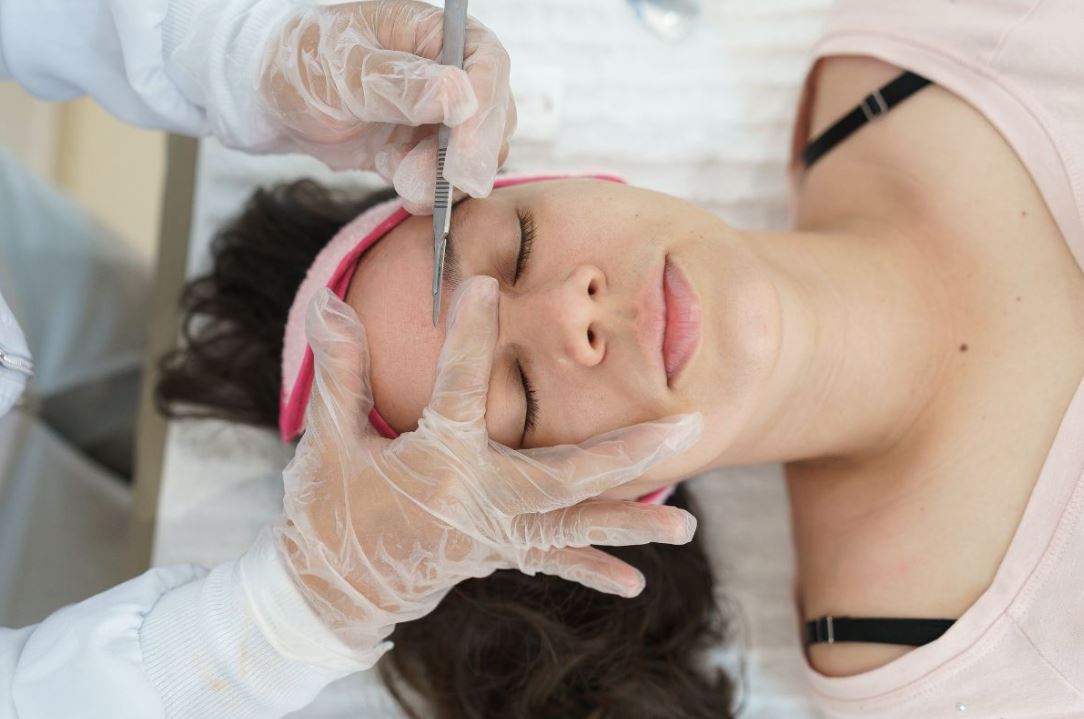If smoother skin is on your wish list, uncover the essentials about dermaplaning: from price points to post-treatment expectations.

Ever looked in the mirror and noticed those tiny, fine hairs casting shadows on your skin, especially under certain lighting? Yep, that’s peach fuzz. If yours is particularly dense or contrasts sharply with your skin tone, you might feel it takes away from that smooth, polished look you’re going for. Beyond appearances, it can also play tricks with your makeup, causing foundation to settle unevenly. Believe it or not, this subtle fuzz might be affecting how well your skincare products work. Want to know how to get rid of this? Try dermaplaning!
What is Dermaplaning?
Dermaplaning is a skincare treatment where a certified aesthetician gently removes the top layer of your skin using a surgical scalpel. The primary objective? To get rid of dead skin cells and fine vellus hair, commonly known as peach fuzz. Originating from the broader concept of exfoliation, this technique has become a popular choice among celebrities and skincare enthusiasts. The reason for its popularity is its precision and the immediate results it offers.
Is Dermaplaning Basically Shaving?
While dermaplaning might resemble shaving due to the use of a blade, they serve different purposes. Shaving is primarily for hair removal. In contrast, dermaplaning treatment targets both hair and the dead skin layer, using a surgical scalpel. The process of shaving can sometimes lead to in-grown hairs or irritations, especially if not done correctly. Dermaplaning, however, when performed by a professional, minimizes these risks for a clean and even exfoliation.
Are Dermaplaning and Dermabrasion the Same?
It’s easy to confuse the two, but they’re distinct treatments. Dermabrasion is a more intensive procedure that “sands” the skin, usually to treat scars or deep wrinkles. It often requires some downtime due to the intensity. Dermaplaning, on the other hand, is a gentler technique focusing on the skin’s superficial layer. You can think of dermaplaning treatment as a meticulous skimming of the skin’s surface, whereas dermabrasion is more akin to deep resurfacing.
What Are the Benefits of Dermaplaning?
Dermaplaning offers multiple advantages:
Smoother Skin: Removal of dead skin results in a smoother texture. Over time, accumulated dead skin can give your face a dull appearance. By removing this layer, you’re revealing fresher skin underneath.
Brighter Complexion: Freshly revealed skin looks more radiant. Without the layer of dead skin cells reflecting light unevenly, your skin can truly shine.
Enhanced Makeup Application: A smoother surface ensures makeup applies more evenly. Foundations and powders won’t get caught in peach fuzz or uneven surfaces. This gives you a flawless finish.
Improved Skincare Efficacy: With dead skin gone, your favorite skincare products can better penetrate the skin. This enhances the effectiveness of serums and moisturizers, allowing active ingredients to nourish the skin more deeply.
How Is It Done?
After cleaning and prepping the skin, a trained aesthetician uses a sterile scalpel to gently scrape off the outermost layer of skin and peach fuzz. The technique requires skill, hence the emphasis on consulting a trained professional.
The scalpel’s angle and the tension applied to the skin play pivotal roles in ensuring the treatment’s success and safety. While there are dermaplaning devices you can purchase online, this isn’t something to attempt at home; the expertise of a professional is paramount.
How Long Does It Take?
A typical dermaplaning session lasts around 30 minutes so it’s a feasible option even for those with tight schedules. Given its relatively quick duration and minimal downtime, it’s earned the nickname “lunchtime treatment” among many busy individuals.
Is Dermaplaning Painful?
Most clients report minimal discomfort. The sensation is often likened to a light scraping, which is generally well-tolerated. Consider it similar to the sensation of a credit card being lightly pushed across the skin. There’s no need for anesthesia but sometimes, your aesthetician may apply some numbing cream to ease any discomfort. This is a testament to the treatment’s gentle nature.
Are There Any Side Effects of Dermaplaning?
Some people might experience temporary redness or a feeling of skin sensitivity post-treatment. However, these effects are usually brief and resolve on their own. A few may notice their skin feels a bit tight or dry after the procedure, but applying a moisturizer can alleviate this. It’s also crucial to use sunscreen post-treatment since the newly exposed skin is more sensitive to the sun.
How Often Should I Dermaplane My Face?
To maintain optimal results and skin health, experts often recommend undergoing the treatment every 3 to 4 weeks. This timeframe allows the skin’s natural regeneration process to take place. Regular sessions can help maintain that fresh, glowing appearance and ensure the consistent removal of dead skin and peach fuzz.
How Much Is Dermaplaning?
The cost of dermaplaning can vary based on several factors, including geographical location and the clinic’s reputation. Dermaplaning prices typically range from $100 to $250 per session. Some clinics like Novique offer package deals or memberships, providing discounts if you decide to make dermaplaning treatment a regular part of your skincare routine.
Say Goodbye to Peach Fuzz – Book Your Appointment Today.
Want to know more about dermaplaning? You can count on us! Call us or step into our clinic to book your appointment today. We serve patients in Philadelphia, Bethlehem and Doylestown, PA, and the Bucks County area.

